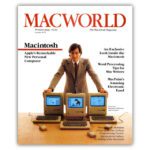How much information is actually in a megabyte? How much is a megabyte converted into book pages or other amounts of information? If 0 and 1 are too abstract for you and if you get stuck with eight bits per byte, you can take a few clear examples with you below. With these, data volumes can also be converted into weight - scientifically somewhat imprecise, but clear;)

Chapter in this post:
How much is a megabyte?
If the so-called SI binary prefixes are used to offset bytes to kilobytes and thus to megabytes, which are usually also used for the binary data volumes based on powers of two, the following explanation results for the information volume of a megabyte:
- 1 byte = 8 bits
- 1 kilobyte = 1.000 bytes = 8.000 bits
- 1 megabyte = 1.000 kilobytes = 1.000.000 bytes = 8.000.000 bits
This designation with the kilo, mega, etc. prefixes, which are actually intended for decimal and not for binary numbers, is still used today - both in popular parlance and in the professional world. The prefixes proposed by the IEC in 1996, which add a “bi” for “binary” to the decimal prefixes, are actually more correct. This classification results from these:
- 1 byte = 8 bits
- 1 Kibibyte = 1.024 bytes = 8.192 bits
- 1 mebibyte = 1.024 kibibyte = 1.048.576 bytes = 8.388.608 bits
It is important to know the correct prefixes, among other things, for the memory of the computer, smartphone, game console and similar devices. in the Wiki articles The following is given on the subject:
[...] Microsoft always calculates with powers of two for data sizes, but then specifies these with the help of the SI prefixes. So a 128 GB storage medium is displayed as 119,2 GB, although according to IEC it should be 119,2 GiB. Added to this is the confusion among users that, according to Microsoft, 120 GB (actually 120 GiB) does not fit on a storage medium advertised as 128 GB and an error is output.
And it continues to say:
For larger decimal and binary prefixes, the distinction becomes more important because the nominal difference becomes larger. Between kB and KiB it is only 2,4%, but between TB and TiB it is already 10%.
Examples of one megabyte of information (book pages and Bible)
For those of you who don't have much to do with data processing, I've also found a few examples that make it easier to imagine a megabyte. Maybe you clicked on this post because you are looking for this one Bible example that you read somewhere;)
For this example, the so-called "standard page" is usually given first, which consists of 30 lines of 60 characters each. In total, the page has 1.800 characters, with one character corresponding to one byte. Since it is not so easy to calculate with 1,8 kilobytes, 2 kilobytes are often used for further calculations. And if a page is 2 kilobytes, then that is 500 times, i.e. one megabyte, a 500-sheet stack of paper pages. At 5 grams per side, we have a "data weight" of 2,5 kg.
And here the Bible example comes into play: Because the pure text from a German-language Bible consumes - assuming the above calculation - around 5 megabytes. In times of gigabytes and terabytes, this is a rather small amount of memory. Around 200 Bibles would fit into one gigabyte.
How big are files that you use every day?
While a book page is given with a unit of measurement of 2 kilobytes, which is rarely used these days, other things can be better imagined. In everyday digital life, for example, we come across not only texts and letters but also images, audio files, films, series and videos. Here is a small overview with guide values for the individual file types (may vary depending on the type, compression, length, formatting, etc.):
- Letter = 1 byte
- Book page = 2 KB
- 1 minute Skype call = 1MB
- Bible text = 5 MB
- Photo, MP3 file = 3 to 5 MB
- Stream music for 1 hour = 40MB
- 1 hour Facebook video = 60MB
- HD video (YouTube, Netflix, Amazon) of 1 hour = 2 GB
- DVD quality film: 5 GB
Examples in the terabyte range
A terabyte is 1.000 gigabytes - or if you use the decimal prefixes for binary numbers: 1.024 gigabytes. An example of books on this scale emerges when looking at the Library of Congress in Washington DC, USA. This library, which is probably the largest in the world with around 30 million books, offers enough material for calculations in the TB area. I read an example in which 200 pages of 1.200 characters each were used for a book. This results in roughly rounded up 30.000.000 TB of information for 7,5 books. And: If you were to collect half a page (1 KB) of data for every (living) person in the world, you would get a data collection of around 7,5 TB as well.
What examples of MB, GB and TB do you know?
How much is a megabyte? Or: how much is a gigabyte? Sometimes you just have to understand such amounts of data with handy examples in order to be able to classify them. If you know more vivid considerations of the topic in addition to books, the Bible and everyday files, then please leave a corresponding comment;)
Related Articles
After graduating from high school, Johannes completed an apprenticeship as a business assistant specializing in foreign languages. But then he decided to research and write, which resulted in his independence. For several years he has been working for Sir Apfelot, among others. His articles include product introductions, news, manuals, video games, consoles, and more. He follows Apple keynotes live via stream.










A Blue Ray is around 18 gigabytes. The same amount of data can fit into a single human DNA. So that's 3600 Bibles if you divide this amount of data by 5MB. This means that a city library fits into a single cell (i.e. only including the books, not including the more modern media).
I don't know where you get your "data" from, but the English Wikipedia sees it differently:
The 2.9 billion base pairs of the haploid human genome correspond to a maximum of about 725 megabytes of data, since each base pair can be coded by 2 bits. Since individual genomes vary by less than 1% from each other, they can be losslessly compressed to roughly 4 megabytes.
So 4 MB is more likely what the DNA of people stores ... This means that your other calculations don't fit either, but as the math teachers always wrote so beautifully: Calculation wrong, but calculation method ok. That's why 1/2 rubber point. : D
You speak of the genome, but not of the DNA. Only one to two percent of DNA are genes. I found some sources on the internet that say 700MB. However, many sources contradict each other.
Fun fact: one gram of DNA contains as much data (215 petabytes) as a 7m x 7m x 2,5m room of cheap hard drives. Theoretically, one gram of DNA could store 3000 book pages for every person who has ever lived.
I have to admit: I'm not a biologist. 😊 And it calms me down when many sources contradict each other. Then I join the list of people with half knowledge. But thanks for your fun fact. It's really funny and impressive.